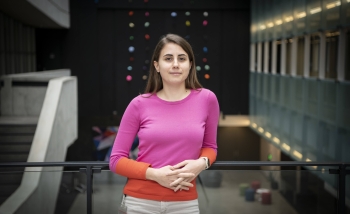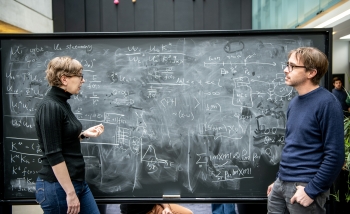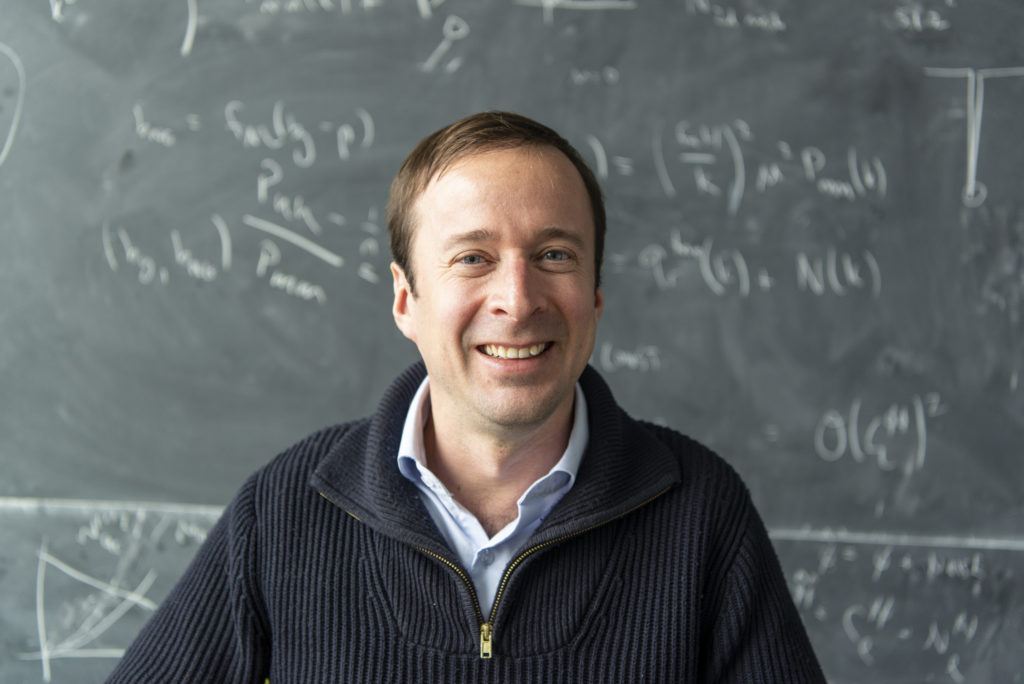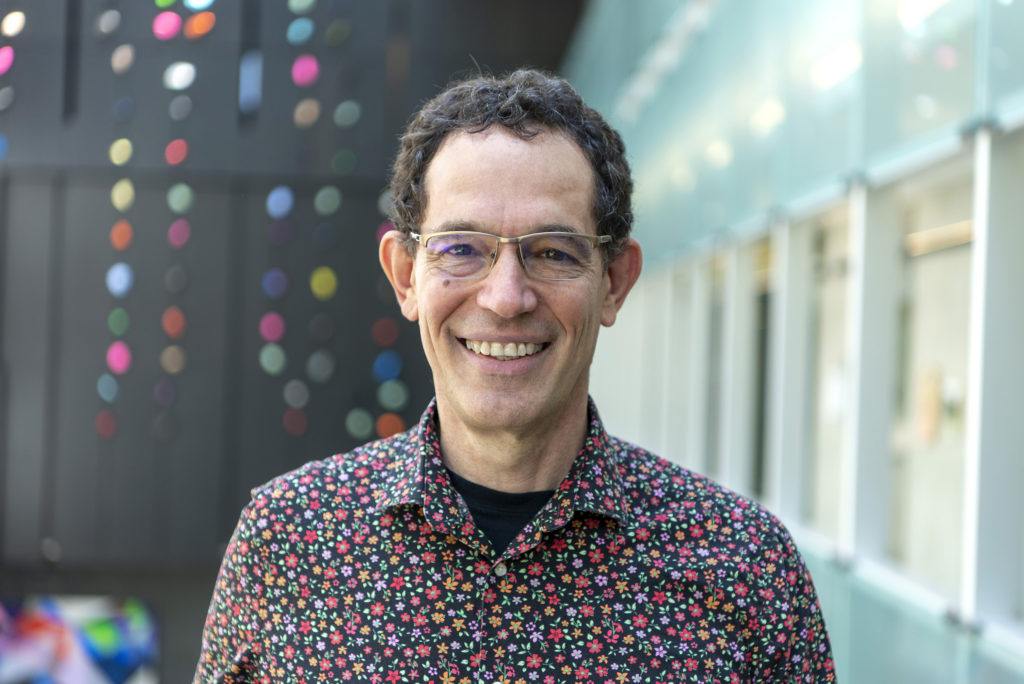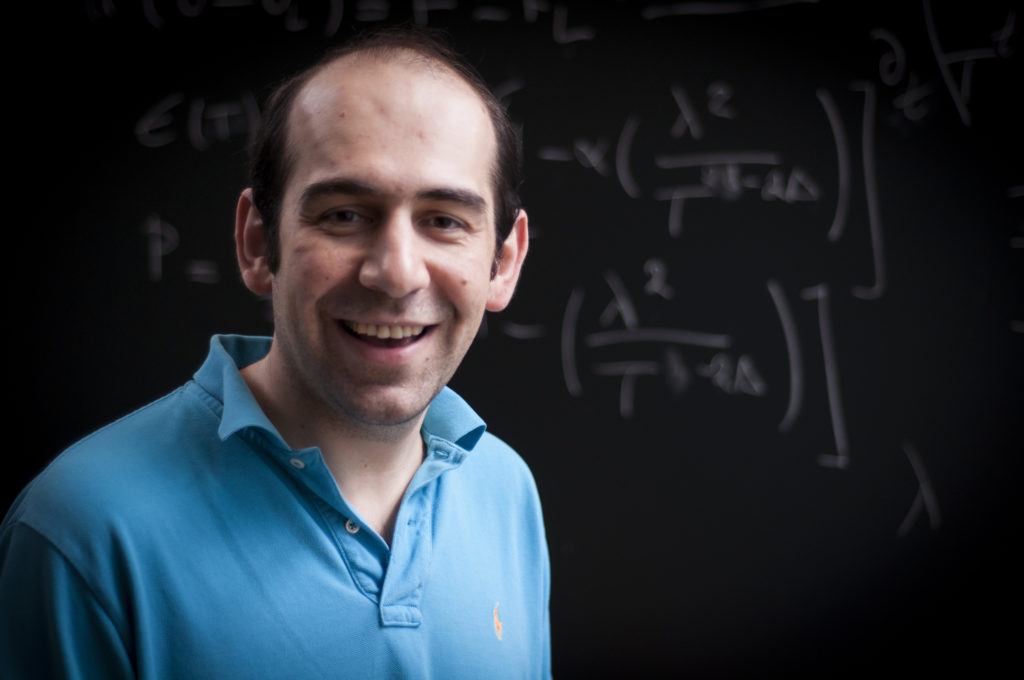Cosmologists are not going to be the ones who defeat COVID-19. But as the novel coronavirus pandemic began to sweep the world in the spring of 2020, many researchers at Perimeter realized there might be a new demand for some of their more specialized skills.
Kendrick Smith and mutation tracking
Kendrick Smith is a cosmologist who’s a world expert in developing mathematical techniques that extract fundamental physics from astronomical data. One of his most recent projects was creating the software pipeline for the CHIME (Canadian Hydrogen Intensity Mapping Experiment) telescope to find fast radio bursts. That skill set made him the perfect person to call on for researchers at McMaster University and Sunnybrook Hospital who are sequencing the genome of the coronavirus.
Genome sequencing is a computationally intensive process – not just because there’s a lot of data, but because the process involves “amplifying” the viral genome and reading it out in small pieces. “Imagine there’s a whole book you want to read, and someone has made a million copies of a few hundred words, and from that you have to reassemble the story,” says Smith.
The McMaster-Sunnybrook team was specifically studying how the genomes of the viruses afflicting individual patients differ from each other – that is, studying the mutation of the novel coronavirus. Some mutations may spread more readily than others. Some may cause more serious disease. And knowing who has what strain can help track how the virus spreads. “It’s a simplification to say there’s only one virus,” Smith notes. “There are hundreds of mutations.”
It’s a huge challenge, and the genomic team needed help from a good software developer – someone with experience with big, messy scientific data sets. They turned to Perimeter, and Director Rob Myers pointed them to Smith, who volunteered his time and got the software pipeline running. Smith is quick to note that this is not his research – the geneticists are the ones actually studying the viral mutations. “But I felt genuinely helpful, and I was really happy to do it. We all want to be of use fighting the pandemic.”
The new software, SIGNAL, is publicly available, and a landmark study comparing the viral genomes in 1,000 different patients is expected soon.
Neil Turok and group testing
Neil Turok is a cosmologist noted for innovating approaches to understanding the big bang and for his work in founding Perimeter’s sister institute, the African Institute for Mathematical Sciences (AIMS). Along with colleagues from AIMS, Turok is working on group testing for coronavirus infections.
Sometimes called “batch testing” or “pool testing,” group testing works by pooling samples from lots of patients. In its most straightforward use, group testing can clear many people at once when the whole group sample tests negative. Turok thought the idea could be pushed further. In the scheme he envisioned, when a group sample tests positive, samples from people in that group could be re-sorted and recombined in new ways, allowing testers to identify individual infected people.
To develop this new group testing scheme, Turok is working with a multidisciplinary team that includes Wilfred Ndifon, a mathematical biologist who is the director of research at AIMS, and Leon Mutesa, a geneticist at the University of Rwanda and coordinator of that nation’s COVID response task force.
Their new scheme works with geometry. Imagine testing a group of nine people, arranged in a three by three grid. Test groups of people by row, and then by column. Imagine you get positive test results from row one and for column three. This means that the individual at row one, column three is the infected person. Testing this way gives row and column “coordinates” for any positive person in a group of nine with just six tests total.
But there is no reason to stop at a grid. What about a cube with rows, columns, and shelves? That’s 27 people with 9 tests. What about a hypercube – that is, a cube with more than three dimensions? In four dimensions, that’s 81 people with 12 tests. In five, it’s 243 people with 15 tests. “For physicists, it’s very natural to reach for higher dimensions,” says Turok. “In fact, I think we do it a little too much. But in this case, it gives us huge practical advantages.”
This testing scheme is already being used in a trial at the University of Rwanda’s state-of-the-art Center for Human Genetics, where team member Mutesa is the director. The idea is even spreading outside of academia, Turok says. “The method is now being used to regularly test one of the top rugby teams in South Africa and is likely to catch on with others.”
These early efforts show that the new group testing scheme can drastically reduce the number of tests needed to identify infected individuals. So far, they have demonstrated a cost reduction of more than a factor of 15 relative to simply testing everyone individually. With further refinements, cost reductions of a factor of 100 appear within reach.
Other public health scientists around the world are starting to come calling.
“It’s early days, but I think this could be a game changer,” says Turok. “In which case: how wonderful, to see it coming out of Africa.”
Niayesh Afshordi and COVID as dark matter
Niayesh Afshordi is an astrophysicist who describes himself as obsessed with the observational hints about the dark energy and dark matter that dominate our universe. His COVID project attempts to use the mathematical ideas of dark matter cosmology to model the hidden presence of the novel coronavirus.
“I think there is a lot in common between epidemiology and cosmology,” Afshordi says. “In both, we have a large component of a mysterious and invisible ‘dark matter’ that surrounds us, and we can only infer its properties indirectly, via incomplete and biased tracers.”
Afshordi collaborated with fellow physicists and with researchers from the computational science giant Wolfram Research. Like astronomers researching dark matter by studying many different galaxies, the team analyzed the entire set of local COVID-19 epidemics in the United States. They included a broad selection of demographics, as well as population density, climate factors, and local mobility data in an attempt to discover what makes a difference to the disease spread, and what doesn’t.
Then, the team used statistical techniques from cosmology to build a model that can make predictions of how the COVID mortality rate might change in response to external factors. The model is now available as a public dashboard, and the team hopes communities can use it to develop good policies – and maybe even save lives.
Mark Penney and network modelling
Mark Penney is a postdoctoral researcher working in mathematical physics. When the pandemic struck, he put his work on topological quantum field theory aside, instead joining with mathematical biologists Chris Bauch of the University of Waterloo and Madhur Anand of the University of Guelph to work on computational models of how the coronavirus spreads.
Their model is based on insight from network theory. It’s a far-reaching and well-developed field, used to study everything from power grids to workflow patterns to predator-prey relationships. The network they’re looking at here is social. Penney explains: “We’re thinking of how the structure of the network of social contacts between people influences how disease is spread.”
It’s not an unusual way to model disease spread, but the team found a way to make the model more powerful by adding percolation theory.
Most people, notes Penney, are familiar with percolating coffee. “In a certain way, an infectious disease spreading throughout a community also follows a percolation-like process. But rather than trying to get the water through the little gaps in the coffee grounds, it’s a virus passing through these social contacts. If you study percolation on a network instead of through a material, it’s the same as studying certain aspects of how infectious disease spreads.”
By building a model of how the coronavirus bubbles through our social networks, the team aims to inform decisions on how best to distribute a limited number of tests or vaccines. “If you can selectively target the more connected individuals, you can use fewer resources to achieve the same reduction in the spread of the disease,” notes Penney.
There are obviously privacy concerns to be reckoned with, but technologies like Canada’s COVID Alert app may offer a way to thread that needle, guiding medical policy decisions without compromising individual privacy.
The team is working to make their model more realistic, and thus more useful. It’s a large project, and Penney suspects it will take most of his attention for the next year. It will be worth it, Penney says, citing one potential payoff: “Some ballparks, based on much more theoretical networks, suggest that with vaccination strategies enabled by COVID Alert you can achieve herd immunity with millions fewer vaccines.”
And many more
These four scientists are among the many Perimeter researchers and alumni who have turned their attention in new directions, leveraging highly developed skills in mathematics, modelling, software, and problem-solving toward helping fight the coronavirus.
From crucial but quick interventions like Smith’s software development, to years-long intensive projects like the one involving Penney, Perimeter works with hope toward a post-pandemic future.
Further exploration
About PI
Perimeter Institute is the world’s largest research hub devoted to theoretical physics. The independent Institute was founded in 1999 to foster breakthroughs in the fundamental understanding of our universe, from the smallest particles to the entire cosmos. Research at Perimeter is motivated by the understanding that fundamental science advances human knowledge and catalyzes innovation, and that today’s theoretical physics is tomorrow’s technology. Located in the Region of Waterloo, the not-for-profit Institute is a unique public-private endeavour, including the Governments of Ontario and Canada, that enables cutting-edge research, trains the next generation of scientific pioneers, and shares the power of physics through award-winning educational outreach and public engagement.
You might be interested in

